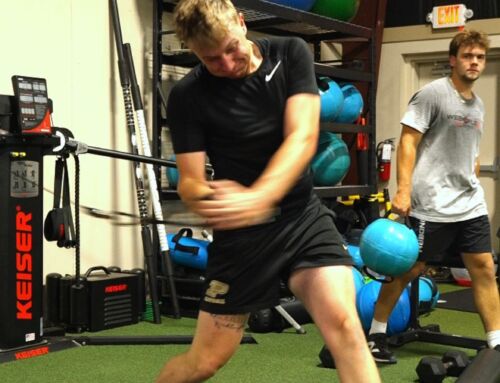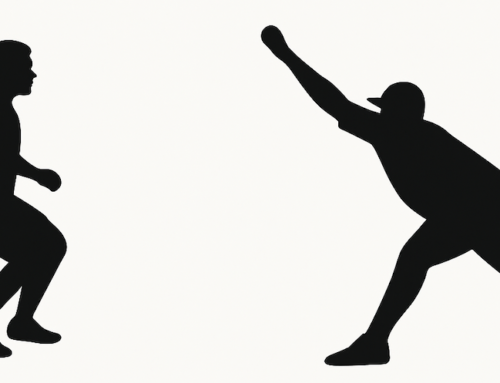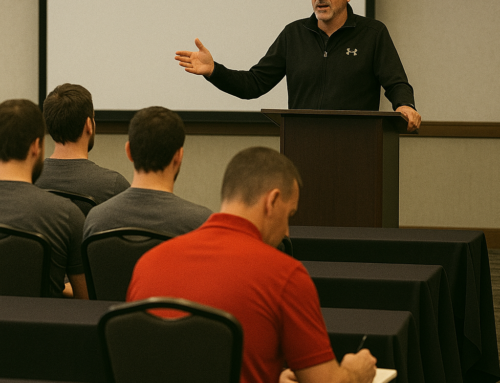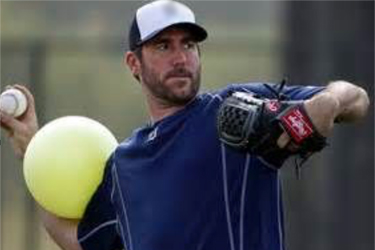
Wait… What?
And here we go again. The long toss and weighted ball police are back at it.
It seems that every week someone posts a titillating headline on twitter.
“Study. Max Distance Throwing Changes Mechanics and Puts More Stress On The Arm.”
It’s often accompanied by this infograph.
First of all… that study is not news. It came out in 2011.
But since we’re getting into it again, I guess I can engage.
The longstanding argument against long toss is as follows: 1) It increases joint stress in the elbow and the shoulder, and 2) throwing mechanics change with increased distance of throws.
Both are true…
And that is exactly why I like long toss… as a training tool.
Ok. So lets go through this again:
We’ll start with the “increases stress” argument.
People in the throwing universe tend to fall into one of 2 categories. You have the “there are only so many bullets in the gun so you should save them” crowd, and then there are those who believe you can load as many bullets as you need.
Here’s the deal. A physiologic principle known as Davis’s Law states that all connective tissue organizes itself to resist the stresses under which it is placed. Davis’s law applies to nearly ALL connective tissue — at least any tissue with a blood supply. Human tissue does not have a free will. It cannot decide not to participate. It can only respond to the stresses we put on it. Therefore, adding stress to a connective tissue will always force an adaptation that can make that tissue more resilient.
People in the “save your bullets” camp – some of them esteemed medical professionals – seem to believe that somehow, the UCL, the labrum, and the rotator cuff are “special” tissues not subject to the laws of nature and therefore cannot be made to become more robust. I would submit that you must add stress to those tissues if you plan to be a high level thrower. If you completely avoid stress you get weak, fragile connective tissue that could be vulnerable to injury. The key is to add stress incrementally over time, gradually increasing the tissue’s ability to resist. If you add stress too rapidly, the tissue fails. If you add it too often or for too long, the body begins to lay down the strongest tissue it knows (bone) and that becomes a calcification.
UCL, the labrum, and the rotator cuff are “special” tissues not subject to the laws of nature and therefore cannot be made to become more robust. I would submit that you must add stress to those tissues if you plan to be a high level thrower. If you completely avoid stress you get weak, fragile connective tissue that could be vulnerable to injury. The key is to add stress incrementally over time, gradually increasing the tissue’s ability to resist. If you add stress too rapidly, the tissue fails. If you add it too often or for too long, the body begins to lay down the strongest tissue it knows (bone) and that becomes a calcification.
Opponents of long toss argue that increased stress on the elbow and shoulder makes it a dangerous practice. I would suggest that not “feeding the arm” with gradually increasing controlled stress as presented in Alan Jaeger’s well known long toss protocol could be even more dangerous.
Now let’s shift gears and tackle the second point of contention… “biomechanics change with increased distance”. You’ll get no objection from me on that one either. The biomechanics of long toss clearly change with every throw… and that’s the beauty of it.
Let me explain.
In every human movement, there are components that must be stable and others that may vary. The stable components are known as “attractors”. The variable components of a movement are considered “fluctuations”. Attractors can be identified by finding patterns that are commonly demonstrated by high level performers. Movements with significant time pressures and those that put the athlete in “at risk” positions if not stable can also be attractors.
The seven key attractors we have found in throwing are:
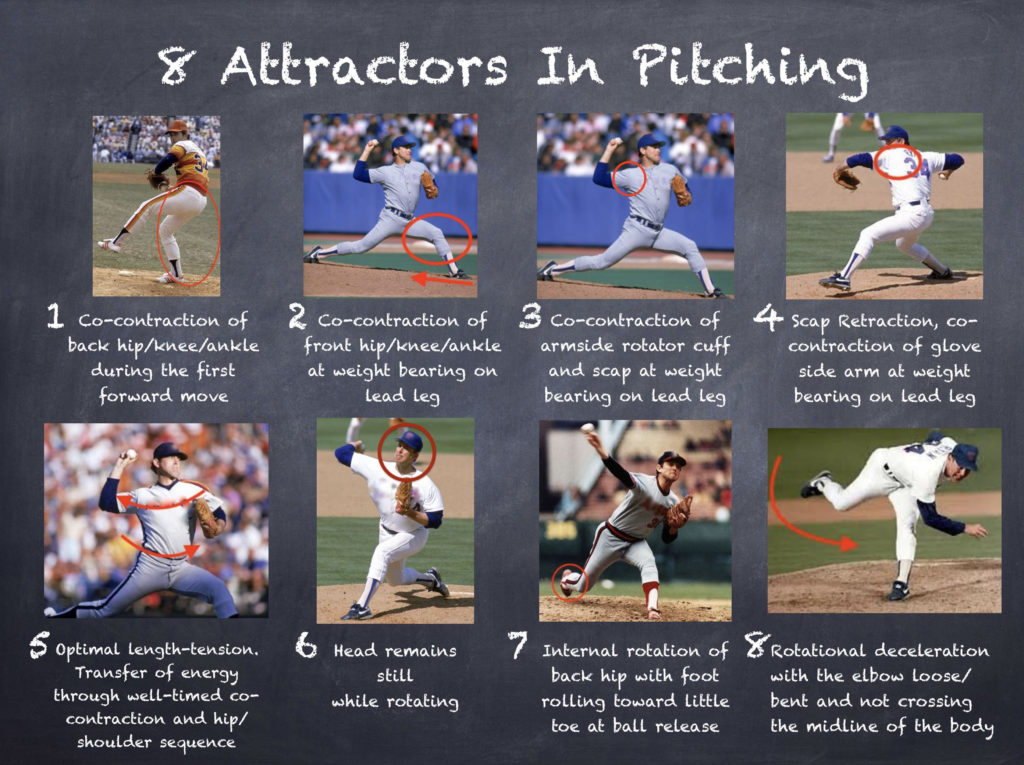
Fluxuations on the other hand, are components of the movement that can vary between athletes and even between repetitions by a given athlete.
Examples of fluctuations might include differences in stride length, depth of back knee flexion, arm slot, lead leg action, tempo, or postural tilt. An adequate number or fluxuations are necessary, but having too many could be detrimental to performance and safety.
When movement attractors are stable, the body automatically begins to eliminates some fluxuations until only a few remain. With less options to choose from, the efficiency and effectiveness of the movement improves. However, if too many fluxuations are removed, the athlete loses adjustability. This can result in rigidity and lack or flow in his movement.
The “Anti-Long Toss” crowd apparently fails to recognize the neurophysiologic dynamics and variability demands of human movement. They’re hooked on the “SAID” principle. That’s an acronym for “Specific Adaptation To an Imposed Demand”. It’s a concept commonly referenced in gyms and physical therapy practices and it means that the body will adapt specifically to the exact demands placed on it. In other words, you don’t learn to putt golf balls by shooting baskets and you don’t strengthen your hamstrings by doing biceps curls. The SAID principle would suggest that the pitchers should only train with 5 oz baseball mound throws at 60’6”, because that represents the exact demand required in a game.
It seems logical until you understand the “degrees of freedom problem” as it relates to attractors and fluxuations.
Dr. Nikolai Bernstein first presented the degrees of freedom problem with his famous “blacksmith experiment”. In this investigation, he showed that the number of motor pattern options for performing any movement is virtually limitless and therefore rigidly repeating a movement is an impossibility.
The “repeatable delivery” does not exist.
Every single throw will present a unique set of subtle deviations or errors. Additionally a pitch doesn’t follow one specific pre-established motor pathway from start to finish. Instead, the neuromuscular system subconsciously adjusts that pattern’s pathway, intensity, timing and synergy throughout the throw. Instead of seeking a “repeatable delivery” we should be going after world-class, real time adjustability of movement.
To optimize movement efficiency you need some fluxuations (but not too many). If your training involves throwing only mound pitches from 60’ 6”, you engrain the attractors so deeply that all of the necessary fluxuators are eliminated and you have no adjustability. Now, when your arm begins to drift outside the rigid boundaries you’ve created, you have no pre-rehearsed motor plan to bring it back. With no capacity for adjustment, the arm could wander into areas beyond tissue failure thresholds, and injury could occur.
The key to safe and efficient throwing is to make sure your attractors are stable, but not too stable and to have just enough fluxuators available to allow sufficient choices for adjustment.
That is the beauty of long toss!
Every throw is a different distance with a different release point and a different coordinative demand. This variability allows you to practice the necessary adjustments subconsciously in a controlled environment, thereby becoming a more efficient and effective thrower.
Similarly, it seems not a week goes by on social media without someone posting something like “The evidence is clear: weighted ball training always results in UCL, labrum and rotator cuff injuries.” Just like long toss, weighted ball training can be a useful tool when implemented responsibly.
This is especially true at The Florida Baseball ARMory. A typical weighted ball protocol in our practice would involve performing 4 different deceleration/connection drills, 5-8 feet from a target pad while sequentially progressing downward in weight from a 2-pound ball, to a 21-ounce ball, to a 14-ounce ball, to a 7-ounce ball, to a 5-ounce baseball and finally to 3-ounce underload ball. Note: in our process, when making full arm action throws, we never go above a 7 ounce ball. In a recent study, Fleisig et al, noted that “pitching with slight variations in ball mass challenges the athlete’s neuromuscular awareness and coordination… and therefore seems like a reasonable variation for training pitchers.”
My sentiments exactly!
So does that mean I am encouraging every throwing athlete to go out today, purchase as set of weighted balls, find a football field and start chucking? Absolutely not! But once your delivery is connected, you are free from massive physical constraints, and you’ve have had an adequate ramp up period, then long toss and weighted ball throwing may be an essential addition to your overall training program.
The variable stimulus presented by long toss and weighted ball training could help you develop adaptable, adjustable movement patterns that add velo, improve command and decrease your risk of injury.
So actually, despite claims to the contrary by the long toss and weighted ball Gestapo, not using long toss and weighted balls could increase the likelihood of getting hurt.
We can’t wait to see you at The ARMory.
Get started by calling, our CFO/COO Amy, at 866-787-4533.
We’ll see you at The ARMory.

Randy Sullivan, MPT, CSCS CEO, Florida Baseball ARMory





